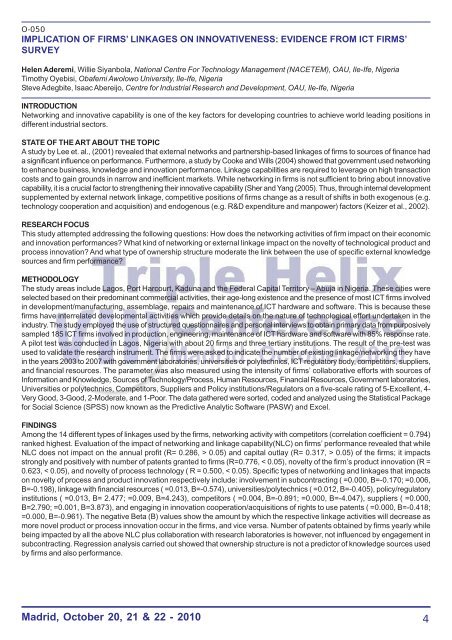TRIPLE HELIX noms.pmd
TRIPLE HELIX noms.pmd
TRIPLE HELIX noms.pmd
You also want an ePaper? Increase the reach of your titles
YUMPU automatically turns print PDFs into web optimized ePapers that Google loves.
O-050IMPLICATION OF FIRMS’ LINKAGES ON INNOVATIVENESS: EVIDENCE FROM ICT FIRMS’SURVEYHelen Aderemi, Willie Siyanbola, National Centre For Technology Management (NACETEM), OAU, Ile-Ife, NigeriaTimothy Oyebisi, Obafemi Awolowo University, Ile-Ife, NigeriaSteve Adegbite, Isaac Abereijo, Centre for Industrial Research and Development, OAU, Ile-Ife, NigeriaINTRODUCTIONNetworking and innovative capability is one of the key factors for developing countries to achieve world leading positions indifferent industrial sectors.STATE OF THE ART ABOUT THE TOPICA study by Lee et. al., (2001) revealed that external networks and partnership-based linkages of firms to sources of finance hada significant influence on performance. Furthermore, a study by Cooke and Wills (2004) showed that government used networkingto enhance business, knowledge and innovation performance. Linkage capabilities are required to leverage on high transactioncosts and to gain grounds in narrow and inefficient markets. While networking in firms is not sufficient to bring about innovativecapability, it is a crucial factor to strengthening their innovative capability (Sher and Yang (2005). Thus, through internal developmentsupplemented by external network linkage, competitive positions of firms change as a result of shifts in both exogenous (e.g.technology cooperation and acquisition) and endogenous (e.g. R&D expenditure and manpower) factors (Keizer et al., 2002).RESEARCH FOCUSThis study attempted addressing the following questions: How does the networking activities of firm impact on their economicand innovation performances? What kind of networking or external linkage impact on the novelty of technological product andprocess innovation? And what type of ownership structure moderate the link between the use of specific external knowledgesources and firm performance?METHODOLOGYThe study areas include Lagos, Port Harcourt, Kaduna and the Federal Capital Territory – Abuja in Nigeria. These cities wereselected based on their predominant commercial activities, their age-long existence and the presence of most ICT firms involvedin development/manufacturing, assemblage, repairs and maintenance of ICT hardware and software. This is because thesefirms have interrelated developmental activities which provide details on the nature of technological effort undertaken in theindustry. The study employed the use of structured questionnaires and personal interviews to obtain primary data from purposivelysampled 185 ICT firms involved in production, engineering, maintenance of ICT hardware and software with 85% response rate.A pilot test was conducted in Lagos, Nigeria with about 20 firms and three tertiary institutions. The result of the pre-test wasused to validate the research instrument. The firms were asked to indicate the number of existing linkage/networking they havein the years 2003 to 2007 with government laboratories, universities or polytechnics, ICT regulatory body, competitors, suppliers,and financial resources. The parameter was also measured using the intensity of firms’ collaborative efforts with sources ofInformation and Knowledge, Sources of Technology/Process, Human Resources, Financial Resources, Government laboratories,Universities or polytechnics, Competitors, Suppliers and Policy institutions/Regulators on a five-scale rating of 5-Excellent, 4-Very Good, 3-Good, 2-Moderate, and 1-Poor. The data gathered were sorted, coded and analyzed using the Statistical Packagefor Social Science (SPSS) now known as the Predictive Analytic Software (PASW) and Excel.FINDINGSAmong the 14 different types of linkages used by the firms, networking activity with competitors (correlation coefficient = 0.794)ranked highest. Evaluation of the impact of networking and linkage capability(NLC) on firms’ performance revealed that whileNLC does not impact on the annual profit (R= 0.286, > 0.05) and capital outlay (R= 0.317, > 0.05) of the firms; it impactsstrongly and positively with number of patents granted to firms (R=0.776, < 0.05), novelty of the firm’s product innovation (R =0.623, < 0.05), and novelty of process technology ( R = 0.500, < 0.05). Specific types of networking and linkages that impactson novelty of process and product innovation respectively include: involvement in subcontracting ( =0.000, B=-0.170; =0.006,B=-0.198), linkage with financial resources ( =0.013, B=-0.574), universities/polytechnics ( =0.012, B=-0.405), policy/regulatoryinstitutions ( =0.013, B= 2.477; =0.009, B=4.243), competitors ( =0.004, B=-0.891; =0.000, B=-4.047), suppliers ( =0.000,B=2.790; =0.001, B=3.873), and engaging in innovation cooperation/acquisitions of rights to use patents ( =0.000, B=-0.418;=0.000, B=-0.961). The negative Beta (B) values show the amount by which the respective linkage activities will decrease asmore novel product or process innovation occur in the firms, and vice versa. Number of patents obtained by firms yearly whilebeing impacted by all the above NLC plus collaboration with research laboratories is however, not influenced by engagement insubcontracting. Regression analysis carried out showed that ownership structure is not a predictor of knowledge sources usedby firms and also performance.Madrid, October 20, 21 & 22 - 20104










